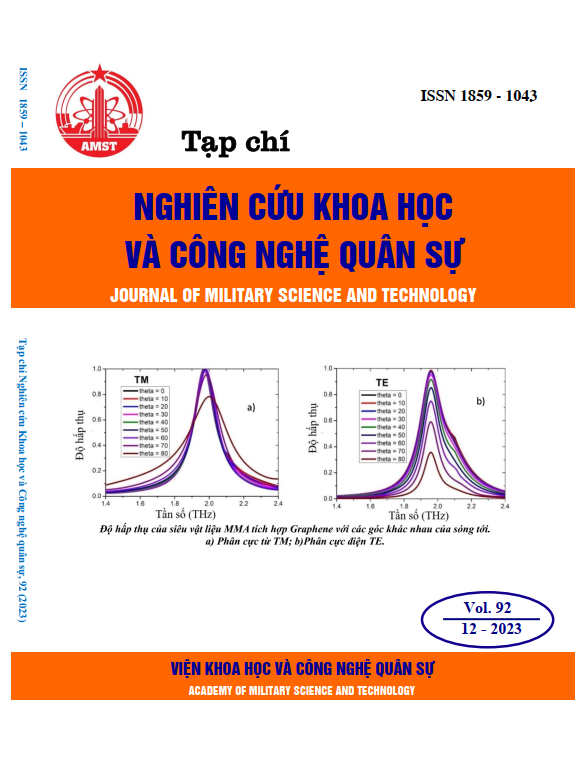Investigating the resonance frequency shift in graphene-integrated metamaterial absorber
427 viewsDOI:
https://doi.org/10.54939/1859-1043.j.mst.92.2023.107-113Keywords:
THz; Metamaterials; Absorb electromagnetic wave; Tunable.Abstract
With great application potential in fields such as high-performance thermal radiation, high-sensitivity biochemical sensors, molecular sensing techniques, and the energy field, THz metamaterial absorbers have attracted much research attention. In particular, research aimed at creating controllable absorbing metamaterials that can change their absorption properties after fabrication through external effects is vital. In this study, we propose a design for a metamaterial absorber that can change its absorption frequency by integrating a graphene mesh. An external electric field can control the resonance frequency of the structure through the Fermi energy of graphene. The MMA structure is simply designed consisting of gold disks placed on a graphene mesh. Simulation results show that the absorption frequency is controlled from 1.67 THz to 1.9 THz corresponding to a change in the Fermi energy of graphene from 0.0 eV to 0.5 eV.
References
[1]. N. I. Landy, S. Sajuyigbe, J. J. Mock, D. R. Smith, and W. J. Padilla, “Perfect Metamaterial Absorber,” Phys. Rev. Lett., vol. 100, no. 20, p. 207402, (2008). DOI: https://doi.org/10.1103/PhysRevLett.100.207402
[2]. W. Zhu, Y. Huang, I. D. Rukhlenko, G. Wen, and M. Premaratne, “Configurable metamaterial absorber with pseudo wideband spectrum,” Opt. Express, vol. 20, no. 6, p. 6616, (2012). DOI: https://doi.org/10.1364/OE.20.006616
[3]. L. Gevorgyan et al., “Tunable ultra-broadband terahertz metamaterial absorber based on vanadium dioxide strips” RCS Adv, vol. 13, pp. 11984–11958, (2023). DOI: https://doi.org/10.1039/D3RA01194A
[4]. L. N. Le, N. M. Thang, L. M. Thuy, and N. T. Tung, “Hybrid semiconductor–dielectric metamaterial modulation for switchable bi-directional THz absorbers,” Optics Communications, vol. 383, pp. 244–249, (2017). DOI: https://doi.org/10.1016/j.optcom.2016.09.014
[5]. Y. Xie et al, “A multifrequency narrow-band perfect absorber based on graphene metamaterial,” Diamond and Related Materials, vol. 137, pp. 110100, (2023). DOI: https://doi.org/10.1016/j.diamond.2023.110100
[6]. X. Liu, T. Tyler, T. Starr, A. F. Starr, N. M. Jokerst, W. J. Padilla, “Taming the Blackbody with Infrared Metamaterials as Selective Thermal Emitters,” Phys. Rev. Lett., vol. 107, no. 4, p. 045901, (2011). DOI: https://doi.org/10.1103/PhysRevLett.107.045901
[7]. Z. Zhou et al, “Ultra-Wideband Microwave Absorption by Design and Optimization of Metasurface Salisbury Screen,” IEEE Access, vol. 6, pp. 26843–26853, (2018). DOI: https://doi.org/10.1109/ACCESS.2018.2835815
[8]. L. Cong, S. Tan, R. Yahiaoui, F. Yan, W. Zhang, and R. Singh, “Experimental demonstration of ultrasensitive sensing with terahertz metamaterial absorbers: A comparison with the metasurfaces,” Applied Physics Letters, vol. 106, no. 3, p. 031107, (2015). DOI: https://doi.org/10.1063/1.4906109
[9]. H. Zhou et al., “Terahertz biosensing based on bi-layer metamaterial absorbers toward ultra-high sensitivity and simple fabrication,” Applied Physics Letters, vol. 115, no. 14, p. 143507, (2019). DOI: https://doi.org/10.1063/1.5111584
[10]. T. V. Do et al., “Design, fabrication and characterization of a perfect absorber using simple cut-wire metamaterials,” Adv. Nat. Sci: Nanosci. Nanotechnol., vol. 3, no. 4, p. 045014, (2012). DOI: https://doi.org/10.1088/2043-6262/3/4/045014
[11]. N. T. Tung and T. Tanaka, “Characterizations of an infrared polarization-insensitive metamaterial perfect absorber and its potential in sensing applications,” Photonics and Nanostructures - Fundamentals and Applications, vol. 28, pp. 100–105, (2018). DOI: https://doi.org/10.1016/j.photonics.2017.12.004
[12]. V. Chabot, D. Higgins, A. Yu, X. Xiao, Z. Chen, and J. Zhang, “A review of graphene and graphene oxide sponge: material synthesis and applications to energy and the environment,” Energy Environ. Sci., vol. 7, no. 5, p. 1564, (2014). DOI: https://doi.org/10.1039/c3ee43385d
[13]. P. R. Gray, P. J. Hurst, S. H. Lewis, and R. G. Meyer, "Analysis and Design of Analog Integrated Circuits", Fifth. Wiley, (2009).
[14]. J. Zhou, E. N. Economon, T. Koschny, and C. M. Soukoulis, “Unifying approach to left-handed material design,” Opt. Lett., vol. 31, no. 24, p. 3620, (2006). DOI: https://doi.org/10.1364/OL.31.003620
[15]. N. T. Hien et al., “Characterizations of a thermo-tunable broadband fishnet metamaterial at THz frequencies,” Computational Materials Science, vol. 103, pp. 189–193, (2015). DOI: https://doi.org/10.1016/j.commatsci.2015.02.038
[16]. Z. Zhihong et al, “Broadband single-layered graphene absorber using periodic arrays of graphene ribbons with gradient width,” Appl. Phys. Express, vol. 8, no. 1, p. 015102, (2015). DOI: https://doi.org/10.7567/APEX.8.015102
[17]. Y. Zhang et al, “Graphene based tunable metamaterial absorber and polarization modulation in terahertz frequency,” Opt. Express, vol. 22, no. 19, p. 22743, (2014). DOI: https://doi.org/10.1364/OE.22.022743
[18]. J. S. Gómez-Díaz and J. Perruisseau-Carrier, “Graphene-based plasmonic switches at near infrared frequencies,” Opt. Express, vol. 21, no. 13, p. 15490, (2013). DOI: https://doi.org/10.1364/OE.21.015490







